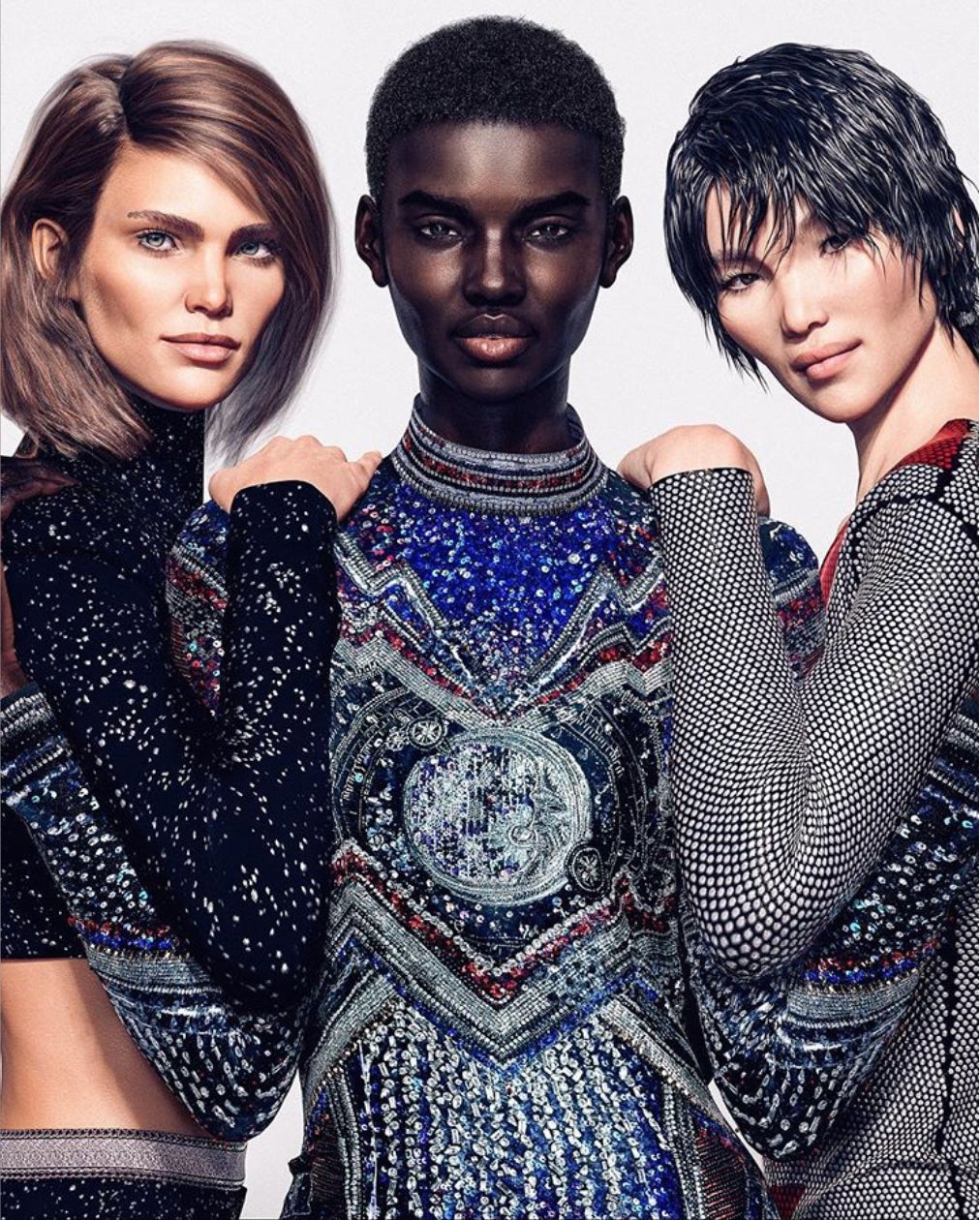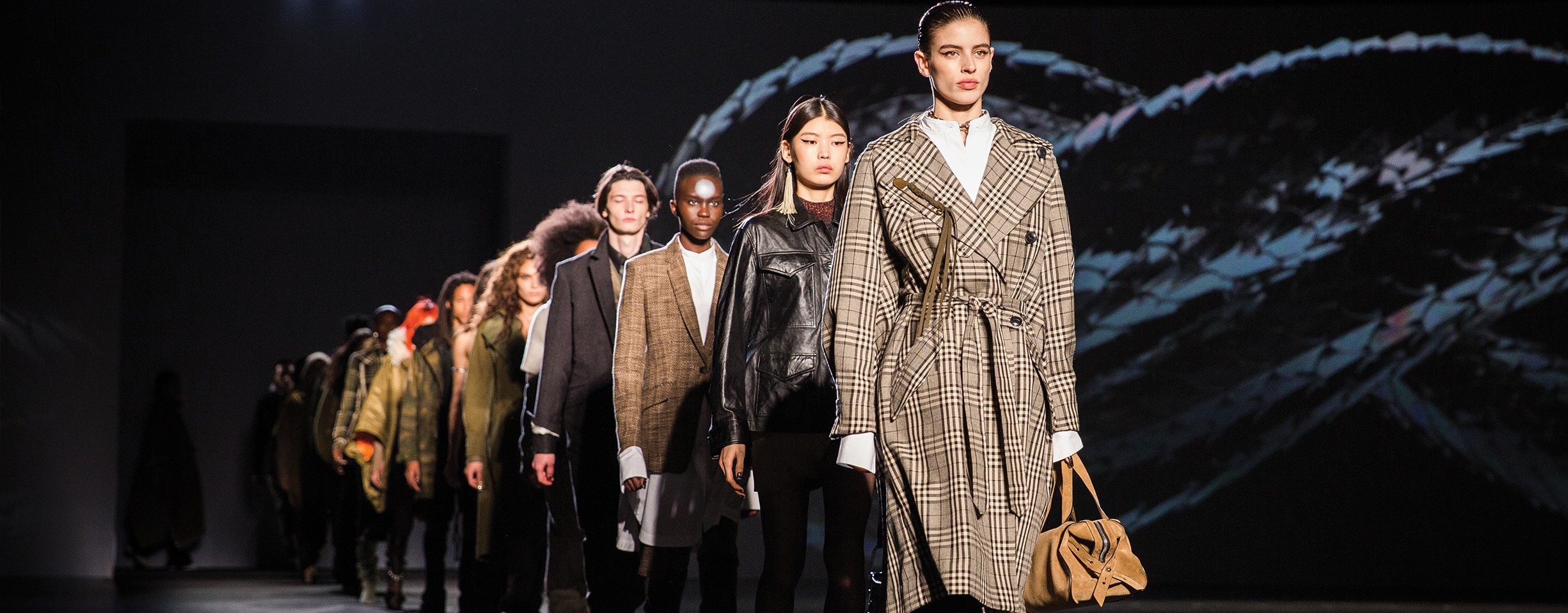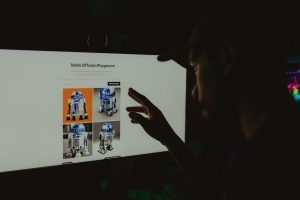Guess just ran an advertisement in Vogue featuring an AI-generated synthetic model and H&M released a campaign with models and their digital twins. The fashion industry is turning towards digitalisation and models are scared their image may be used or re-used without their permission. So how do they address issues like copyrights, financial exploitation and job security in an era that is increasingly digitalised?

Balmain army of digital models!
The rise of disruptive technologies—particularly artificial intelligence—is transforming the modelling industry at its core. As brands turn towards digital twins and avatars, the fabric of the industry is being rewoven—one pixel at a time. While digital twins and AI-generated models offer operational benefits like availability, cost reduction and hyper-customisation—they also raise ethical and legal concerns.
Fashion models must be aware that unauthorised use of their photographs is a violation of their rights. Per Model Alliance: “The fashion industry is built on inequitable power structures and the frequent exploitation of workers — and this has been the case since long before AI came on the scene. The steps we take together now will determine whether AI entrenches these imbalances or helps us reimagine a fairer, more equitable industry.” Fashionabc looks at the changing face of modelling and highlights the steps that models must take to avoid financial exploitation, image abuse, uncompensated reuse, and job displacement.
The Rise Of Digital Twins
The pace of creativity and digital innovation is rapidly increasing in fashion and there is a race among fashion brands to innovate and stay ahead of the curve.
In 2018, Balmain launched a CGI-created Balmain Army of digital models. During the global pandemic, the luxury fashion brand opened a virtual showroom, hosted by an avatar of Creative Director Olivier Rousting. Recently, it launched non-fungible token loyalty program ‘Balmain Thread’ and collaborated with Space Runners on phygital sneakers that came with NFT collectibles. In 2023, Levi’s partnered with digital studio Lalaland.ai to showcase its collections using hyper-realistic AI-created models. The goal was to increase representation and help consumers see themselves modelling the clothes, promoting a more inclusive and personalized experience.
H&M is using digital twins of fashion models in their marketing campaigns and social media, with the models consent. Fashion models’ jobs will not be endangered as they are part of the process of creating and using these AI-generated digital twins. “We’re exploring new territory — generative AI — and discovering how technology can unlock new ways to showcase our design in innovative ways, while still staying humble to our human-centric approach”, said Jörgen Andersson, Chief Creative Officer, H&M on LinkedIn. “We are using digital twins created through generative AI, developed closely together with models and their agencies. What’s key is that the creative process and outcomes remain firmly controlled by the people involved.”
When Vogue US August 2025 issue hit the newsstands with a two‑page spread for Guess subtly labelled, “Produced by Seraphinne Vallora on AI”, the campaign’s AI-generated hyper‑perfect model, which treads the line between photorealism and impossible beauty standards, sparked a viral debate about beauty ideals. When a culturally influential publication promotes an AI-created models, it sends a message: artificial perfection is the new aspirational standard. To avoid regressing into a digitally enhanced monoculture, the industry must approach AI with intentionality—ensuring that innovation does not come at the cost of authenticity, visibility, and equity.

Image source: Seraphinne Vallora
Ethical Considerations of Digital Models
AI-driven fashion models also raise concerns about job security. Models, fashion photographers, stylists and makeup artists fear that automation could threaten their livelihoods as AI-generated avatars can perform the same tasks—posing for campaigns, walking on virtual runways, and creating visual content for social media. However, industry insiders suggest that AI will complement fashion models, not replace them. “I see digital models as something that is very situational and works well for certain things but not so for others. Both can coexist and also work together”, British photographer Cameron James-Wilson tells BBC. “With any new technology there’s always a polarised discussion – some people are staunchly against it, and some people embrace it.”
Fashion Workers Act
After years of campaigning, New York passed a law, signed by Governor Kathy Hochul on December 21, 2024, that will give fashion models working in the state greater protection from exploitation, harassment and abuse and the growing use of AI.
The Fashion Workers Act closes the legal loophole by which model management companies have escaped accountability and also creates labour protections for models. The law, which went into effect in June 2025, grants models access to contracts with their clients, increased transparency into expenses, safeguards against harassment and abuse, and a formal channel to report violations without fear of retaliation.
In addition to safeguarding models from abuse and prohibiting any retaliatory action for filing complaints, the new law also provides recourse for the unauthorised use of digital images and AI. It calls for written consent for the creation or use of a model’s digital replica, and highlighting the scope, purpose, rate of pay and duration of such use.
As artificial intelligence technologies evolve, the potential for deepfakes and digital replicas of models has become a significant risk to both their livelihoods and rights. The Act specifically addresses these concerns by ensuring that models have control over their digital likeness and image. By establishing clear guidelines on consent, compensation, and intellectual property, the Fashion Workers Act mandates that models must give explicit approval for any use of their image in AI-generated content or digital replicas, thereby safeguarding them from unauthorised exploitation.
Furthermore, the Act introduces crucial measures to ensure transparency and fair compensation for models whose images are used in AI-driven projects. This law also demands that fashion companies disclose how they intend to use a model’s likeness, ensuring that models are compensated appropriately for the use of their digital representations. With these regulations in place, the Fashion Workers Act creates a framework for ethical practices and sends a message to workers across the fashion industry that models deserve to be treated with dignity and respect just like anyone else who works for a living.
How models can protect themselves against digital images

Image Source: New York Fashion Week
Understand Intellectual Property Rights: Models should educate themselves about intellectual property (IP) rights, particularly how copyright and image rights apply to their likeness. Even if AI generates an image based on a model’s appearance, the model’s likeness may still be protected under IP law, and unauthorised use could constitute infringement.
Sign Clear Contracts: Before any photoshoot or appearance, fashion models should ensure their contracts clearly state whether their image can be used for AI generation or digitalisation. The contract should specify usage rights, including any AI-related alterations, and provide explicit consent clauses.
Monitor Image Usage: models must regularly monitor their images online. Tools like reverse image search or AI-based tracking software can help fashion models detect unauthorised use of their likeness in AI-generated images. Identifying misuse early can help initiate legal action quickly.
Retain Image Control with Licensing: When models provide images for photoshoots, they should ensure that licensing terms are clearly defined. Models can retain control over how their images are used by specifying usage limitations, such as prohibiting AI generation or requiring additional compensation if their likeness is used for such purposes.
Seek Legal Action or AI-Driven Solutions: If a model’s likeness is used without consent in AI-generated images, they should consult a lawyer specializing in IP or digital rights. Legal actions may include sending cease-and-desist letters, seeking damages, or negotiating for compensation. Additionally, AI solutions that help track image usage or prevent unauthorised use can also be explored.
Jasmeen Dugal is Associate Editor at FashionABC, contributing her insights on fashion, technology, and sustainability. She brings with herself more than two decades of editorial experience, working for national newspapers and luxury magazines in India.
Jasmeen Dugal has worked with exchange4media as a senior writer contributing articles on the country’s advertising and marketing movements, and then with Condenast India as Net Editor where she helmed Vogue India’s official website in terms of design, layout and daily content. Besides this, she is also an entrepreneur running her own luxury portal, Explosivefashion, which highlights the latest in luxury fashion and hospitality.











